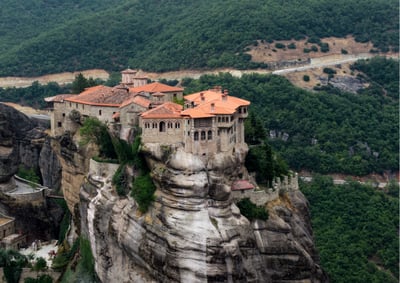Meteora, Greece
/ in Greece small group tours, tour of greek islands, greece food and wine, things to do in Greece, greece travel, visit Greece, Meteora Greece, Greece / by smadar PalaceThe Greek word Meteora translates to “suspended in the air” and that perfectly describes this peaceful and ethereal region in Greece. Other terms that seem to suit this unique place are celestial, mystical, magical, and of course, breathtaking. It’s no wonder this serene locale is the site of six different monasteries. Its presence alone evokes a sense of spiritual peace and tranquility.
Paradise Found
If Meteora sounds too good to be true we can assure you it’s the real thing. And even if you aren’t looking to connect with your spiritual side, a visit to this beautiful region will enchant you nonetheless. From a purely worldly point of view Meteora cannot help but create a connection between man and nature.
Here we delve into the history of this naturally stunning place and how it serves to promote man’s everlasting desire to connect to something otherworldly and Divine.
A Sacred Place
The monasteries of Meteora were built in the 14th century however the Christian pilgrims flocked here long before then. From the early days of Christianity these rugged cliffs and rocky outcroppings beckoned to those who longed for a deeper connection. Hiking the rugged and Ricky terrain of Meteora offered the isolation required for deep contemplation. And, let’s face it, the views are truly heavenly.
Orthodox monks living as hermits began their retreats to Meteora in the 9th and 10th centuries. They found it the ideal place to isolate inside caves or along the secluded cliffs where they would dwell in peace and contemplation supported by locals who brought these holy men food and gifts of comfort.
These early days were the beginning of the monastic development of Meteora. The number of hermit monks gave 12th century monk Nilos an idea. He went to Meteora to create a more organized existence for this dedicated group of Cliff- and cave-dwellers.
The Monasteries of Meteora
Nilos gathered the holy men into a monastic organization with rules and canons of holy decree. This was the beginning of monasteries in Meteora. The hermit monks’ first order of holy business was to create a chapel. The chapel, Doupiani, still stands today in the shadow of a cliff by the same name. And, just as their brothers did centuries ago, the monks still gather every Sunday in this ancient chapel to share in worship and gratitude and also any provisions they may bring.
In the 14th century another monk, Athanasios, ascended the second highest point in Meteora to establish the first official monastery, The Great Meteoron. Athanasios is still regarded today as a major figure in the Orthodox Church and recognized as founder of the most important monastery in Meteora.
By the 16th century Meteora’s monastic community grew to 24 monasteries. These monasteries thrived for the next hundred years until the 17th century began to see a decline in monastic life in Meteora. Still today there are 6 active monasteries.
The architecture of the monastic ventures remains a favorite among visitors to Meteora. Each monastery is unique and offers a glimpse into the lives of the monks. Appreciated for their religious significance, wonderful architecture and absolutely breathtaking views of the surrounding mountains and rugged scenery.
Hiking and Trails and Views, Oh My
In addition to the monasteries of Meteora the region offers plenty of opportunity for hiking and trail climbing. Hikes range from fairly easy ambles along a paved trail which takes you to some of the monasteries to an adrenaline-fueled climb to the Great Saint, the tallest point in Meteora, which is recommended only for those experienced hikers and takes you along dirt trails and through forested areas.
A “Fun” Visit
One unique and quite interesting thing to do in Meteora is to visit the Mushroom Museum. While you’ll learn so much and see so much surrounding this fabulous fungi, there is much more to pique the interests of any natural history buff. More than 300 preserved animal exhibits and 250 mushroom exhibits are there to fascinate and educate.
Attached to the museum you’ll find the Neromilos restaurant where it is possible to dine on a six course meal composed entirely of mushrooms, including drinks and desserts. After your meal, wander the shop and pick up something for yourself or the mushroom lover at home.
If There Are Monks There Must Be Wine
Of course, where there are monks you are bound to find wine, right? One of the more interesting vineyards, started by monks, is on sloping terrain near the prehistoric cave of Theopetra. The vineyard dates back centuries and although destroyed by the phylloxera that plagued many European vineyards in the late 1800s, a local family brought the vineyard back to life and added to it in the 1990s.
The area around Meteora is filled with vineyards and many people carry on the tradition of wine making begun by Meteora’s monks. The area is also recognized for their production of Tsipouro, a strong distilled spirit made from the remnants and residue left after the grapes are pressed for wine.
Many Reasons to Visit Meteora
As you might imagine this place of such awe-inspiring beauty, such spiritual and mystical presence and religious significance is a UNESCO World Heritage Site. Natural beauty. Cultural heritage, historical significance and a magical kind of energy draw visitors from all over to this sacred place. Come find out why Meteora should be on your list of desirable destinations.

Share this article
-
Share on Facebook
Share on Facebook
-
Share on Twitter
Share on Twitter
-
Share on WhatsApp
Share on WhatsApp
-
Share on Pinterest
Share on Pinterest
-
Share on LinkedIn
Share on LinkedIn
-
Share on Tumblr
Share on Tumblr
-
Share on Vk
Share on Vk
-
Share on Reddit
Share on Reddit
-
Share by Mail
Share by Mail


